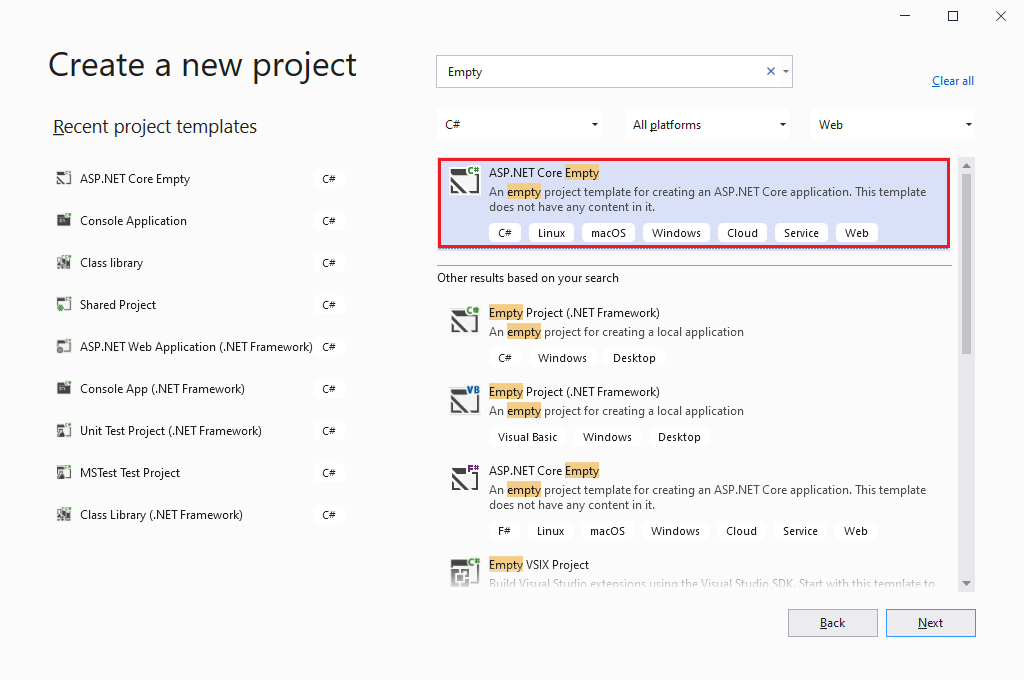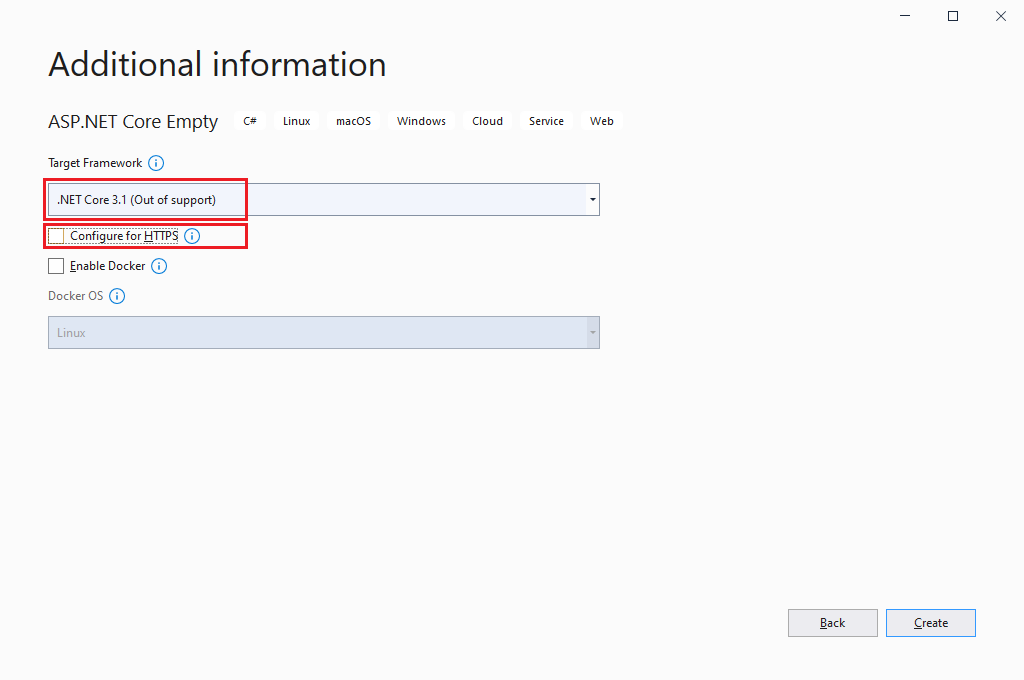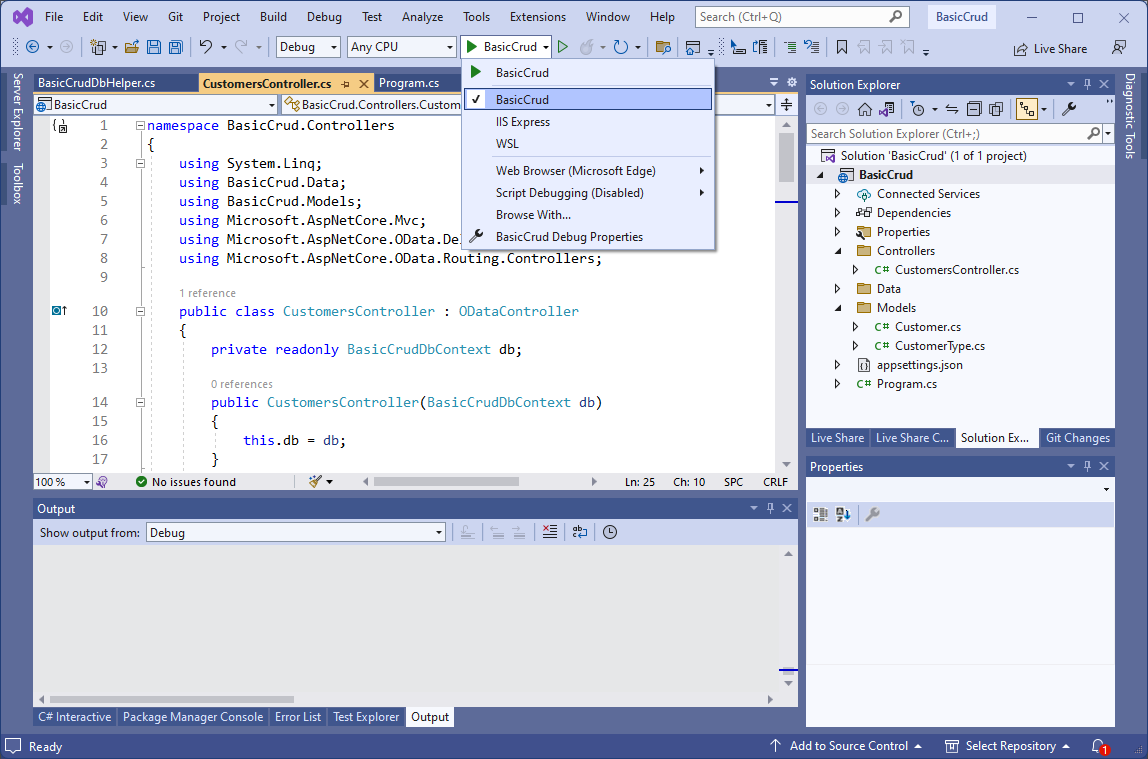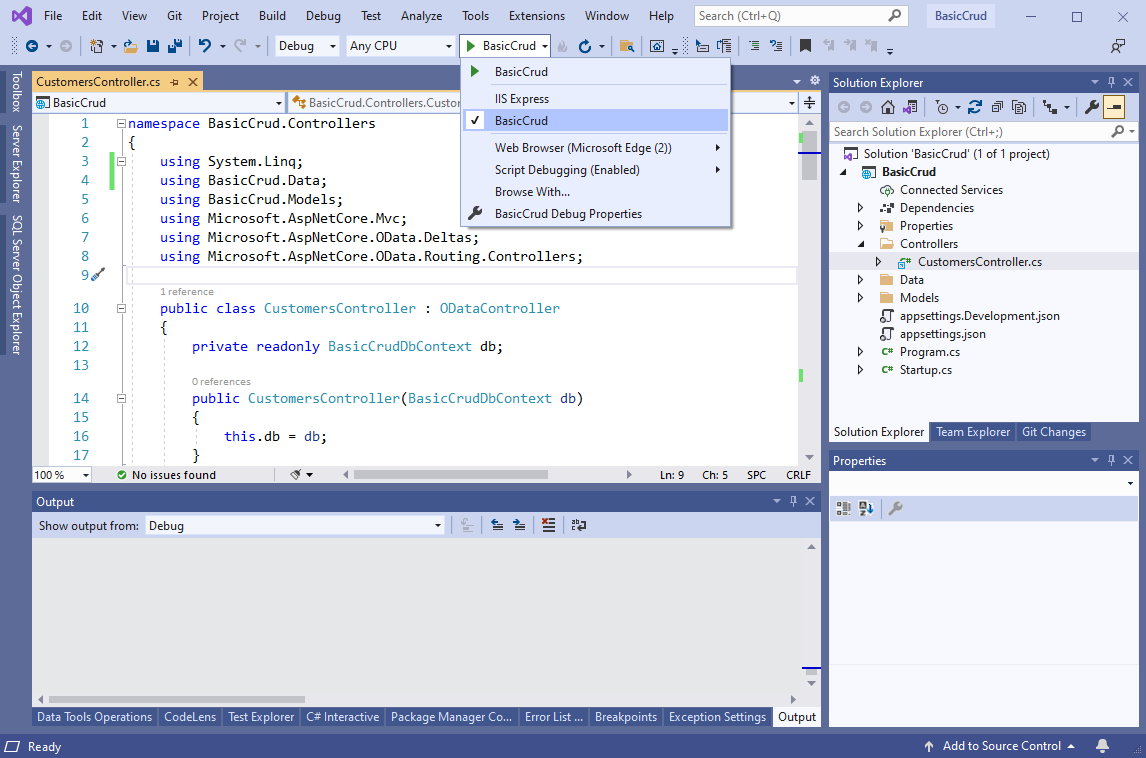Note
Access to this page requires authorization. You can try signing in or changing directories.
Access to this page requires authorization. You can try changing directories.
Applies To:# OData Web API 8 supported OData Web API v8
OData Web API v8
This tutorial shows how to implement basic CRUD (Create, Read, Update, and Delete) in an ASP.NET Core OData 8 service
You'll learn how to:
✅ Create an ASP.NET Core application
✅ Install required packages
✅ Add data models
✅ Add a database context
✅ Build the Edm model and configure the service
✅ Add an OData controller
✅ Run the OData service
✅ Request entity collection
✅ Request a single entity
✅ Create an entity
✅ Update an entity
✅ Delete an entity
Prerequisites
Visual Studio 2022 with the ASP.NET and web development workload
Create an ASP.NET Core application
Start Visual Studio 2022 and select Create a new project.
In the Create a new project dialog:
Enter
Emptyin the Search for templates search box.Select ASP.NET Core Empty project template and select Next.
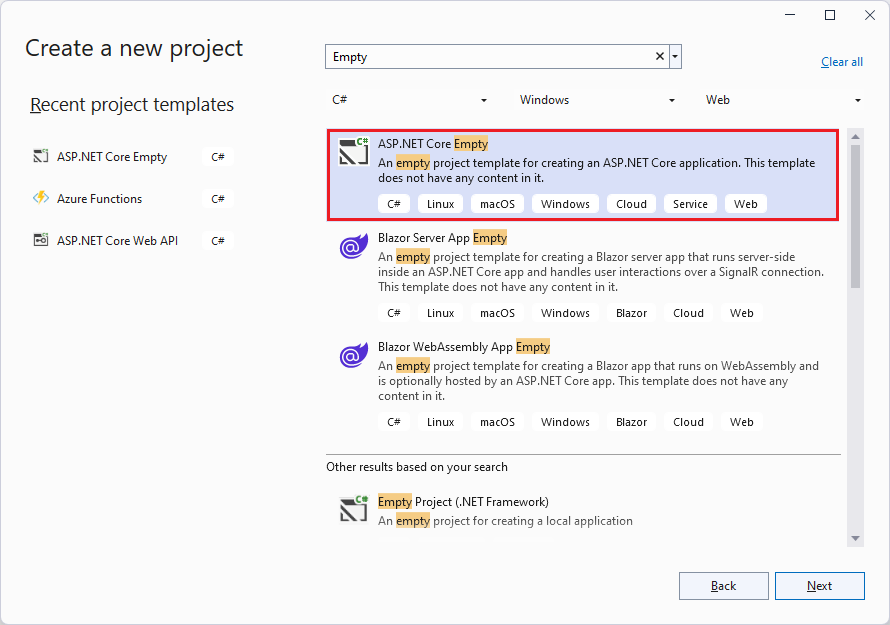
Name the project BasicCrud and select Next.
In the Additional information dialog:
- Select .NET 6.0 (Long Term Support).
- Uncheck Configure for HTTPS checkbox.
- Select Create.
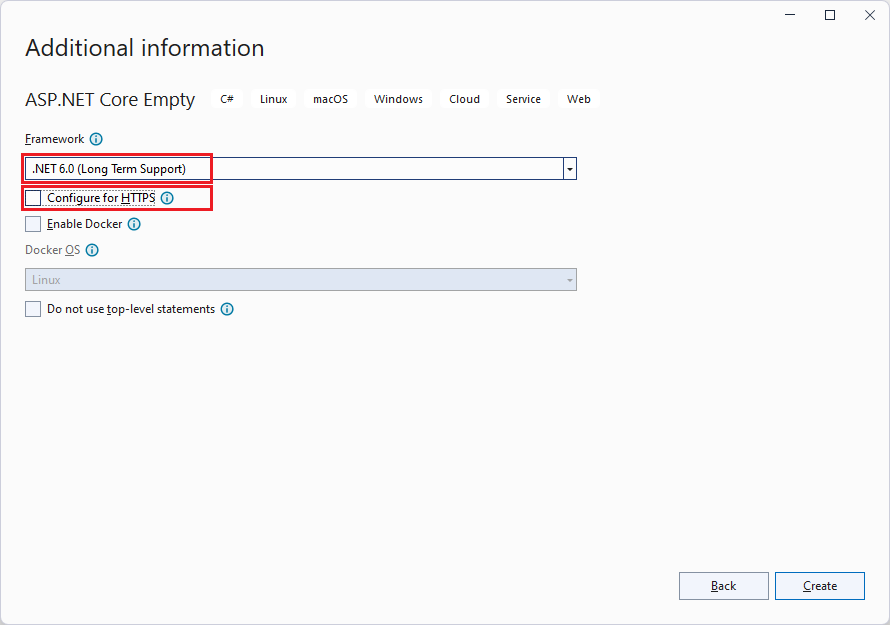
Install required packages
Install the following Nuget packages:
In the Visual Studio Package Manager Console:
Install-Package Microsoft.AspNetCore.OData
Install-Package Microsoft.EntityFrameworkCore.InMemory
In addition to the Microsoft.AspNetCore.OData library, we are installing the Microsoft.EntityFrameworkCore.InMemory library in order to use the Entity Framework Core in-memory database.
Note: .NET Core 3.1 does not support Microsoft.EntityFrameworkCore.InMemory 6 or higher. You will need to specify a lower version.
Add data models
Add a folder named Models to the project and then add the following types.
CustomerType enum
namespace BasicCrud.Models
{
public enum CustomerType
{
Retail,
Wholesale
}
}
Customer class
namespace BasicCrud.Models
{
using System;
public class Customer
{
public int Id { get; set; }
public string Name { get; set; }
public CustomerType CustomerType { get; set; }
public decimal CreditLimit { get; set; }
public DateTime CustomerSince { get; set; }
}
}
We define a CustomerType enum type and a Customer class. The Id property in the Customer class will serve as the unique key in our database.
Add a database context
The database context is the main class that coordinates Entity Framework functionality for a data model. This class is created by deriving from the Microsoft.EntityFrameworkCore.DbContext class.
Add a folder named Data to the project and then add the following class:
namespace BasicCrud.Data
{
using BasicCrud.Models;
using Microsoft.EntityFrameworkCore;
public class BasicCrudDbContext : DbContext
{
public BasicCrudDbContext(DbContextOptions<BasicCrudDbContext> options)
: base(options)
{
}
public DbSet<Customer> Customers { get; set; }
}
}
In the same folder, add the following helper class named BasicCrudDbHelper containing logic to help us seed the database.
namespace BasicCrud.Data
{
using System;
using System.Linq;
using BasicCrud.Models;
internal static class BasicCrudDbHelper
{
public static void SeedDb(BasicCrudDbContext db)
{
if (!db.Customers.Any())
{
db.Add(new Customer
{
Id = 1,
Name = "Sue",
CustomerType = CustomerType.Retail,
CreditLimit = 3700,
CustomerSince = new DateTime(2022, 7, 4)
});
db.Add(new Customer
{
Id = 2,
Name = "Joe",
CustomerType = CustomerType.Wholesale,
CreditLimit = 5100,
CustomerSince = new DateTime(2022, 12, 12)
});
db.SaveChanges();
}
}
}
}
Build the Edm model and configure the service
using BasicCrud.Data;
using BasicCrud.Models;
using Microsoft.AspNetCore.OData;
using Microsoft.EntityFrameworkCore;
using Microsoft.OData.ModelBuilder;
var builder = WebApplication.CreateBuilder(args);
var modelBuilder = new ODataConventionModelBuilder();
modelBuilder.EnumType<CustomerType>();
modelBuilder.EntitySet<Customer>("Customers");
builder.Services.AddControllers().AddOData(
options => options.EnableQueryFeatures(null).AddRouteComponents(
routePrefix: "odata",
model: modelBuilder.GetEdmModel()));
builder.Services.AddDbContext<BasicCrudDbContext>(options =>
options.UseInMemoryDatabase("BasicCrudDb"));
var app = builder.Build();
app.UseRouting();
app.UseEndpoints(endpoints => endpoints.MapControllers());
// Seed database
using (var serviceScope = app.Services.GetRequiredService<IServiceScopeFactory>().CreateScope())
{
var db = serviceScope.ServiceProvider.GetRequiredService<BasicCrudDbContext>();
BasicCrudDbHelper.SeedDb(db);
}
app.Run();
We're using the ODataConventionalModelBuilder to build the Edm model. As part of the model, we register CustomerType as an enum type and Customers as an entity set - Customer entity type also gets registered as a result. We then proceed to add essential OData services by calling the AddOData method, in the process enabling different OData query features - $filter, $orderby, $top, etc. The AddRouteComponents method is also called to register a route - odata, passing along the Edm model to associate it with.
In addition, we're also registering the database context as a service with the dependency injection (DI) container. The DI container will provide the service to the controllers.
The other thing that we are doing is to seed our database with some data by calling SeedDb method from our BasicCrudDbHelper class. We resolve the BasicCrudDbContext service from the DI container and pass it to the SeedDb method. There will be only one instance of BasicCrudDbContext in the lifetime of the application.
Add an OData controller
In this tutorial, we are going to use conventional routing. OData's conventional routing takes advantage of naming and structural conventions. For example, if you define an entity set named Customers, the framework expects to find a controller named CustomersController to handle requests to that endpoint. Once the framework determines which controller should handle the request, it further applies method conventions. For example, HTTP GET requests are mapped to methods like Get() or Get([key]) in the controller. Similarly, HTTP POST, PUT, PATCH, and DELETE requests are routed to their corresponding methods. To learn more about OData routing, visit the routing overview tutorial.
Add a folder named Controllers and then add the following C# class.
namespace BasicCrud.Controllers
{
using System.Linq;
using BasicCrud.Data;
using BasicCrud.Models;
using Microsoft.AspNetCore.Mvc;
using Microsoft.AspNetCore.OData.Deltas;
using Microsoft.AspNetCore.OData.Routing.Controllers;
public class CustomersController : ODataController
{
private readonly BasicCrudDbContext db;
public CustomersController(BasicCrudDbContext db)
{
this.db = db;
}
}
}
In the controller, we add a contructor that accepts a BasicCrudDbContext parameter. Since we registered BasicCrudDbContext as a service in the DI container, ASP.NET Core will take care of resolving the database context as a dependency and injecting into our controller - constructor injection.
We will add controller actions to this controller progressively to support different CRUD operations.
Run the OData service
Before running the service, select the debugging profile named after the project - BasicCrud - to use ASP.NET Core Kestrel web server.
Press F5 to build and run the application.
You may get a security warning about installation of a certificate from a certification authority (CA). You can choose not to allow the certificate to be installed.
After the application has launched, take note of the endpoint that the application is listening on - http://localhost:5173 though the port might differ depending on the version of Visual Studio and other environmental settings.
Stop the application.
In the sections that follow, we implement support for different CRUD operations. After implementing support for each particular operation, you can re-run the application to test the functionality.
Request entity collection
To support the ability to return all Customer entities from an OData service, we implement a controller action to handle that request. Add the following logic to the CustomersController class:
public ActionResult<IQueryable<Customer>> Get()
{
return Ok(db.Customers);
}
In the above block of code, we're calling the an ASP.NET Core built-in method - Ok() that internally prepares a status 200 OK response. We pass the Customers DbSet into the method to return all customers in our database. A DbSet represents a collection of entities of a specific type.
The following GET request returns all customer entities:
GET http://localhost:5173/odata/Customers
The following JSON payload shows the expected response:
{
"@odata.context": "http://localhost:5173/odata/$metadata#Customers",
"value": [
{
"Id": 1,
"Name": "Sue",
"CustomerType": "Retail",
"CreditLimit": 3700,
"CustomerSince": "2022-07-04T00:00:00+03:00"
},
{
"Id": 2,
"Name": "Joe",
"CustomerType": "Wholesale",
"CreditLimit": 5100,
"CustomerSince": "2022-12-12T00:00:00+03:00"
}
]
}
Request a single entity
To support this request, we add a controller action named Get (or GetCustomer) to the CustomersController class. The action should accept a single parameter named key of type int - same type as the entity's key property:
public ActionResult<Customer> Get([FromRoute] int key)
{
var customer = db.Customers.SingleOrDefault(d => d.Id == key);
if (customer == null)
{
return NotFound();
}
return Ok(customer);
}
In the above block of code, we're using LINQ to write an expression to retrieve a entity with the specified key from the Customers table. We return a status 404 NotFound if we don't find any match; otherwise we return the matched entity.
The FromRoute attribute is only added for documentation purposes to show that the parameter should be bound using route-data from the current request - it is neither necessary nor mandatory.
Note that for the built-in routing conventions to route the request successfully, the key parameter should be named key. This is a pitfall that people who are unfamiliar with OData routing find themselves in. If you choose to rename the parameter, specify the route template on the controller action - attribute routing basically. The following block of code shows how to do it:
[HttpGet("odata/Customers({id})")]
public ActionResult Get([FromRoute] int id)
{
var customer = db.Customers.SingleOrDefault(d => d.Id == id);
if (customer == null)
{
return NotFound();
}
return Ok(customer);
}
The following GET request returns the customer with a key value of 1:
GET http://localhost:5173/odata/Customers(1)
The above request makes use of the parentheses-style key. An alternative way is to use the key-as-segment convention as follows:
GET http://localhost:5173/odata/Customers/1
The following JSON payload shows the expected response:
{
"@odata.context": "http://localhost:5173/odata/$metadata#Customers/$entity",
"Id": 1,
"Name": "Sue",
"CustomerType": "Retail",
"CreditLimit": 3700,
"CustomerSince": "2022-07-04T00:00:00+03:00"
}
Create an entity
To support this request, we add a controller action named Post (or PostCustomer) to the CustomersController class. The action should accept a single parameter of type Customer, decorated with FromBody attribute:
public ActionResult Post([FromBody] Customer customer)
{
db.Customers.Add(customer);
db.SaveChanges();
return Created(customer);
}
Unlike FromRoute attribute from the previous section, the FromBody attribute applied to the customer parameter is necessary. It specifies that the parameter should be bound using the request body.
The following POST request creates a Customer entity:
POST http://localhost:5173/odata/Customers
Here's the request body:
{
"Id": 3,
"Name": "Luc",
"CustomerType": "Retail",
"CreditLimit": 2300,
"CustomerSince": "2022-10-01"
}
The Created method used in the controller action returns a status 201 Created response. It also generates and returns the location of the created entity. If you look through the response headers, you should find the following Location header:
http://localhost:5173/odata/Customers(3)
Update an entity
We can update an entity using PUT or PATCH request. The PUT method updates the entire entity (i.e. replaces the entity) while the PATCH method applies a partial update to the entity (i.e. modifies the entity).
Update an entity using PUT
To support this request, we add a controller action named Put (or PutCustomer) to the CustomersController class. The action should accept two parameters - the first is the key of the target entity and the second is a parameter of type Customer decorated with FromBody attribute:
public ActionResult Put([FromRoute] int key, [FromBody] Customer updatedCustomer)
{
var customer = db.Customers.SingleOrDefault(d => d.Id == key);
if (customer == null)
{
return NotFound();
}
customer.Name = updatedCustomer.Name;
customer.CustomerType = updatedCustomer.CustomerType;
customer.CreditLimit = updatedCustomer.CreditLimit;
customer.CustomerSince = updatedCustomer.CustomerSince;
db.SaveChanges();
return Updated(customer);
}
The following PUT request updates customer 2:
PUT http://localhost:5173/odata/Customers(2)
Here's the request body:
{
"Id": 2,
"Name": "Joe",
"CustomerType": "Retail",
"CreditLimit": 0,
"CustomerSince": "2022-04-27"
}
The above request will update the entire entity. You can query for the entity to confirm the result of the PUT operation.
Update an entity using PATCH
To support this request, we add a controller action named Patch (or PatchCustomer) to the CustomersController class. The action should accept two parameters - the first is the key of the target entity and the second is a parameter of type Delta<Customer> decorated with FromBody attribute:
public ActionResult Patch([FromRoute] int key, [FromBody] Delta<Customer> delta)
{
var customer = db.Customers.SingleOrDefault(d => d.Id == key);
if (customer == null)
{
return NotFound();
}
delta.Patch(customer);
db.SaveChanges();
return Updated(customer);
}
The following PATCH request patches customer 2:
PATCH http://localhost:5173/odata/Customers(2)
Here's the request body:
{
"CreditLimit": 1300,
"CustomerSince": "2022-01-26"
}
The above request will only update the CreditLimit and CustomerSince fields. You can query for the entity to confirm the result of the PATCH operation.
Delete an entity
To support this request, we add a controller action named Delete (or DeleteCustomer) to the CustomersController class. The action should accept the key parameter:
public ActionResult Delete([FromRoute] int key)
{
var customer = db.Customers.SingleOrDefault(d => d.Id == key);
if (customer != null)
{
db.Customers.Remove(customer);
}
db.SaveChanges();
return NoContent();
}
The following DELETE request deletes customer 2:
DELETE http://localhost:5173/odata/Customers(2)
